
HARU NO UMI
Haru no Umi traditional Japanese style offers guitarists something different. Haru no Umi, originally a piece for koto (a traditional Japanese stringed instrument) and shakuhachi (a Japanese flute), was composed in 1929 by Michio Miyagi. It is Miyagi’s best-known piece and one of the most famous for that instrumental combination. Here, Eugène den Hoed has arranged the guitar part (so I assume the flute part is roughly the same as the original shakuhachi part). On YouTube there is an enlightening, nearly eight-minute performance on the original instruments from 2010 that shows how closely den Hoed has stuck to that arrangement in his guitar part, and also the instances he has had to change some notes. The mention of rubato in the speed marking of “Lento e poco rubato” is also interesting, because that recorded performance reveals how much freedom the performers take with the speed when playing this piece. The work uses traditional scales throughout, and the sound is captivating and very atmospheric. Both parts share the limelight at different times and the guitar is often, but not always, playing campanella-style arpeggio patterns of one sort or another. As a result the part is not too difficult to master, although the flute player has many arabesques to play, and as such has to be a considerable player. If the traditional Japanese sound is to your liking, this wonderful piece of writing could make a welcome change from your normal repertoire.
Chris Dumigan – Classical Guitar (USA)

NUANCES AND IMAGINATION
Iduna Muziehuitgeverij V.O.F. 35pp (nowadays published by d’OZ).This is a collection of 16 intermediate pieces that in the words of the Preface ‘offer a range of different musical atmospheres’. They are widely diverse in both music and their technical requirements and yet are written with accessibility in mind.
With this I absolutely agree. The first thing that strikes you about all the pieces is an almost folky element to the harmonies. I then realised that the writer has often used modal harmonies in a most individual way so that they constantly s\ound fresh and individual. An initial strangeness in their writing gives way quickly to the feeling that you are playing something compellingly individual that grabs you musically. There are literally no second-rate pieces here but really outstanding ones include Shades, with its second section that I couldn’t get out of my head; the almost robotic Trip to Mechanism I; the warmly emotive The End of A Sunny Sunday; the wonderfully oriental sound of The Geisha that absolutely refuses to include any hackneyed ‘oriental’ intervals yet sounds perfectly right and correct and the delightfully quirky Twisted Logic.
I cannot stress enough I enjoyed this fabulous book, which is full of wonderful music. Any decent player will get such a lot from it that it should be on all our shelves.
Chris Dumigan – Classical Guitar (USA)

TWO SUITES for two guitars
by Joseph Bodin de Boismortier
Muziekuitgeverij Iduna V.O.F. Score only 36pp.
The Dutch guitarist Eugene den Hoed has produced some marvellous works over the years. This latest one is an arrangement for two guitars from an original instrumental source but as there are no specific details, I can’t tell you what it was originally written for. The two suites concerned are a nine-movement one in C and a seven movement one in G.
The first one in C is very playable. There are not usually more than three or four voices in total over the two guitars and it all fits very well indeed. There is a pleasant allemande, a slightly surprising Fanfare, a work one doesn’t normally find in a baroque suite, a minuet, courante, rondeau, pavane, and a pair of da capo rigaudons to finish. If you can sense a little reticence in my words, it is because I found the music pleasant though sometimes rather dull. I love playing baroque on the guitar and have great respect for Den Hoed, but, oh for a modulation here and there to break the monotony.
The second suite in G did nothing new to change my opinion gained from the first suite. It was nice and playable, and fitted well under the hands. At least here there were a couple of movements in G minor to relieve the constant three-chord trick.
The standard of the arranging is very high, and as I said previously the music is playable and clear and finely fingered and produced.
Chris Dumigan – Classical Guitar (USA)
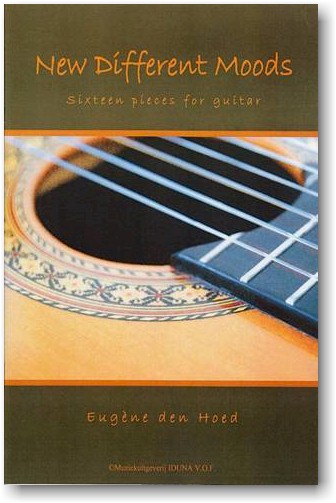
NEW DIFFERENT MOODS
Muziekuitgeverij Iduna V.O.F.
This Dutch composer always writes good, interesting and effective material and the latest bunch of 16 short, yet quite substantial works is no exception.
They are varied in style and content, yet all have a lack of the obvious or hackneyed phrase and harmony, as they manage to sound fresh and new; just unusual enough to keep your interest.
They range from the tongue-in-cheek Tangolito, to the almost folk-like A Quiet Afternoon, or the almost enigmatically harmonised Morning Dew. They tend to be of moderate difficulty although some of the difficulty factor stems from the occasional unusual chord shape or group of notes that can catch you by surprise but then again they are some of the delights in playing these pieces, for you really don’t know what you are going to find.
This is a fine set, with much to enjoy, and if you do not know this man’s music, take a flyer and give them a go, for you will almost certainly not be disappointed.
Classical Guitar – October 2013
Chris Dumigan – Classical Guitar (USA)

CD – MUSIC FOR GUITAR
Serenade; A Train in the Distance; Another Evocation; The Candy Store; Sentimental Strings; Cameleon Blues; Divertimento; Praeludium, Theme and four Variations; Evocations Nos. 1, 2, 9 and 8; A Fancy; Story Without Words; The Naughty Clown; Tropical Delight; Some Small Hours; Fantasia nos. 4 and 5. JOSEPH BODIN de BOlSMOTIER, from ‘music for two guitars’: Sauteuse; Air; Rondeau. The published works which I have encountered through reviewing editions by this Dutch composer have usually been met with approval and satisfaction. According to the sleeve notes to this privately released album, Eugène den Hoed has recorded his complete output for sologuitar on four discs, and this CD under review contains a selection -27 tracks in all – from the other four recordings; a ‘sampler’ if you like. Listed as ‘bonus’ tracks are three duets (performed with Maxim Slock) by the French Baroque composer JOSEPH BODIN de BOISMORTIER. Although the music on the album is of a good standard, the CD is more likely to appeal to anyone studying den Hoed’s music rather than a disc to have on in the car or as background music etc. The obvious appeal here is to hear the composer playing the music as intended and to this purpose I can recommend this recording.
Steve Marsh – Classical Guitar, september 2008

THE MYSTERIOUS GUITAR for solo guitar by Eugène den Hoed.
The Dutch guitarist Eugène den Hoed (once a member of the symphonic popgroup ‘Bonfire’) is a prolific composer of guitar music and, according to what little knowledge I can gleam from a small bit of research, has the admirable ambition to write contemporary music aimed specifically at the intermediate player. From the evidence of this new edition under review and several others reviewed recently, he is achieving this project in quite a successful manner. The Mysterious Guitar is subtitled A Modern Suite for Guitar and has altogether nine movements. Each movement has a descriptive title and most of them to the expectations conjured by the name, hence The Woods So Dark has an ominous presence: The Stratosphere gives an ‘other-worldly’ impression; Mysterious Journey is… just that (shades of the Swiss composer, Frank Martin in this movement) and so on. Eugène den Hoed obtains many of the effects by utilising one of the guitar’s most useful features, the campanella: this overlapping of notes seems a particular characteristic of this composer and one he uses to good effect. As stated earlier, Eugène den Hoed has recently set out to compose student guitar pieces in a ‘modern’ mode without becoming too avant-garde and with The Mysterious Guitar suite he has produced an attractive, interesting, stylish and relatively sizeable piece. For any student of around the Grades 5-6 mark wanting to try something substantial and musically adventurous, this is well worth considering.
Steve Marsh Classical Guitar

14 MIGNONNETTES for solo guitar by Eugène den Hoed.
Muziekuitgeverij Iduna 0V. l4pp (nowadays published by d’OZ). Continuing in his quest to write interesting contemporary guitar music for the lower-intermediate student, Dutch guitarist Eugène den Hoed has here produced a collection of short works aimed slightly below the technical standard he has been producing recently, this one geared more towards the grades 3-4 player. There are 14 pieces in total all given descriptive titles to capture the imagination of the player and are brief, individual, stand-alone works as opposed to his recent publications which were full-scale and relatively lengthy guitar compositions – a ‘Suite’ and a ‘Sonatina’ (Sonatina Ostinato), hommage à Leo Brouwer). With Mignonnettes den Hoed has kept to a more traditional method of composition with the majority of the pieces being tonal in character. A fairly comprehensive range of keys and rhythms are covered and for the standard Hoed is aiming at, these could provide a pleasant supplement in the student teaching material catalogue.
Steve Marsh – Classical Guitar

EVOCATIONS 1-6 by Eugène Den Hoed.
Muziekuitgeverij Iduna V.O.F. 24pp (nowadays published by d’OZ). Subtitled Six Impressionistic Pieces these enterprising items are graded 5-6. They are eminently accessible and yet are written in an unusually harmonised style that succeed in sounding quite original and do not rely on hackneyed guitaristic figurations so prevalent in some compositions. They do not have any sub-titles and are merely numbered 1-6 but are quite substantial in size. In general the whole set which amounts to nearly 25 minutes of music uses figurations that are eminently playable. Interesting to see and hear and yet quite individual. The music is charming and like little else that I have tried before yet isn’t modern enough to scare your granny. Nicely printed, this volume was a refreshing change from some music one gets to see and hear.
Chris Dumigan – Classical Guitar

HOMMAGES POUR GUITARE for solo guitar by Eugène den Hoed.
Muziekuitgeverij lduna VOF 28pp (nowadays published by d’OZ). Here are nine contemporary pieces for solo gultar composed by a guitarist who, as well as studying classical guitar, also has strong connections with pop and blues bands (e.g. the instrumental progressive rock group of the 70s, Bonfire). Each composition in this album pays its own tribute to some of the best-known composers which should be recognisable to most classical guitarists. Hence there are homages to Bach, Sor, Rodrigo, Ponce, Giuliani, Piazzolla, Tárrega, Carlevaro and Brouwer. Most of the music has strong connections, stylistically, with the dedicatees but there are a few where this connection is a trifle tenuous and it is difficult to ‘get’ the association, but even so, all the collection are very well written and thoughtfully constructed for the guitar, with most of the notes falling neatly under the fingers. Of particular interest are the cormpositions paying tribute to Ponce and Carlevaro, the former one, a very beautiful work being in the manner of a Nocturne and the latter one a delightfully animated Sicilienne. These compositions are, without a doubt, a really valuable addition to the contemporary repertoire for the intermediate student and this is a book I will be uslng with my students. Recommended!
Steve Marsh – Classical Guitar
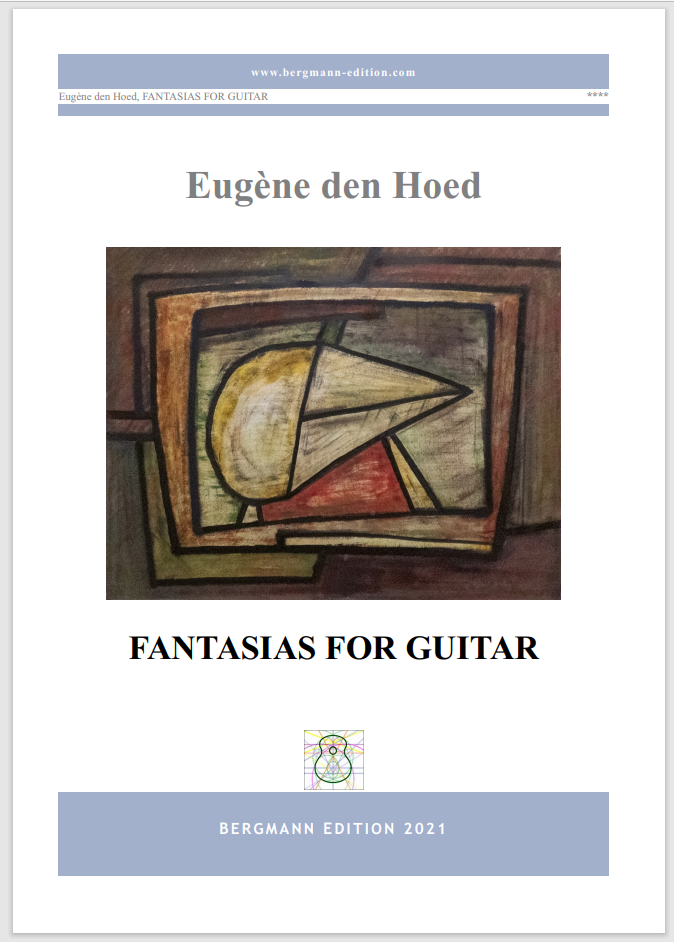
FANTASIAS FOR GUITAR for solo guitar by Eugène den Hoed.
Muziekuitgeverij Iduna VOF 36pp. These nine fantasias are aimed around the intermediate level of difficulty; their intention is to try and augment the repertoire of contemporary guitar music and enable the student to try out and appraise ‘modern’, atonal music without having to struggle with the likes of Bennett, Henze, Martin, etc. Despite the dictionairy definition of a Fantasia being a compositlon structured according to the composer’s fancy, these nine pieces are actually written in a stricter form than that implies and are quite accessible both to the ear and from a technical viewpoint. There is some very good writing contained within these pieces and a brief set of three or four pieces could easily be created from this book to be included in the informal student concert or the like. Presentation is very good with clear printing and sensible fingering by the composer.
Steve Marsh – Classical Guitar

GUITAR REFLECTIONS for solo guitar by Eugène den Hoed.
Muziekuitgeverij Iduna VOF 34pp. This is the third book of compositions to date which I’ve reviewed by this composer, who, until just a few weeks ago was an unknown name to me. Guitar Reflections shows Eugène den Hoed in a different manner to his other two reviewed works which dealt with intermediate level contemporary atonal music in the one book and compositions written in the styles of renowned composers in the other. This new edition is aimed more at the lower intermediate student and is composed in a more ‘traditional’ style as regards tonality. I didn’t think the 20 studies in this book were as attractive and appealling as his more difficult compositions but nevertheless there are quite a number of pieces here which many students will surely find pleasing and with diligent practise should help develop techniques such as legato, scale passages, arpeggios, higher positions, etc. The music is very well presented and is adequately fingered.
Steve March – Classical Guitar

IMPRESSIONATAS for solo guitar by Eugène den Hoed.
Muziekuitgeverij Iduna VOF 26pp. This compilation of grades 3-4 pieces are in a similar vein to the same composer’s Guitar Reflections, where a collection of studies, sixteen in this book, are presented to the student to improve not only their repertoire but also various guitar techniques such as arpeggios, slurs, scales, phrasing, high positions, etc. From a personal viewpoint I found these pieces a little more attractive than the ones contained in the afore mentioned book. They contain some nice melodic lines, interesting harmonies and some excellent rhythmic material for the student to get to grips with. Well worth a look at.
Steve Marsh – Classical Guitar

TWELVE DIFFERENT MOODS by Eugène den Hoed.
Muziekuitgeverij Iduna V.O.F. 16pp (nowadays published by d’OZ). Here is another book from this fine Dutch composer whose 12 Evocations so impressed me recently. Here his little pieces are aimed squarely at the lesser grades, these being graded 3—4. Each little piece is one page in length and they do vary considerably from the slightly enigmatic Breeze on the Water whose mostly quaver movement manages to be sad and restless at the same time to Another Drunken Sailor, which sounds like a sea shanty. On the other hand we have A Fancy, which is quasi-Elizabethan in style, or A Story Without Words which goes almost pictorially through a number of contrasting moods. Noisy Traffic speaks for itself with its semitonal clashes imitating car horns, whereas Latin Holidays has a certain amount of offbeat accents and would help the less able players to understand how to approach this style of music. I found this little set very useful, quite fun and well-written for the guitar. Any interested parties should have no hesitation in given it a chance.
Chris Dumigan – Classical Guitar

EVOCATIONS 7- 12 by Eugène den Hoed.
Muziekuitgeverij Iduna V.O.F. 28pp (nowadays published by d’OZ). Book 2 of these ‘Six Impressionistic Pieces for Guitar’ as they are subtitled, are all astep harder than the Book 1 (See separate review) The composer grades them as 6—7, and like Book 1 they are composed in a modern – impressionistic idiom with each evocation having its own characteristics in structure, tempo and harmonies. Yet again this book, like its companion reveals some surprisingly adventurous music, completely tonal yet never obvious and each of the pieces is a wonderfully complete separate item on its own. I could see a small number of these being perfect as a suite to play in the middle of your recital. Great!
Chris Dumigan – Classical Guitar
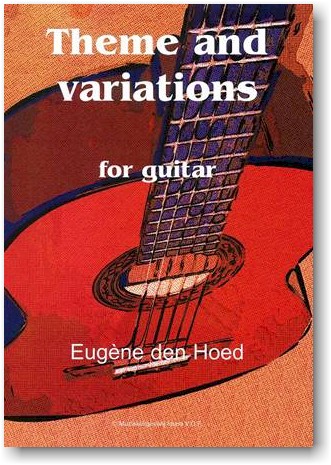
THEME AND VARIATIONS by Eugène den Hoed.
Muziekuitgeverij Iduna V.O.F. 12pp. Right from the start this piece makes quite an arresting effect as the Theme itself is in single notes and its intervals are quite wide in range, thus making for quite an unusual yet completely tonal idea that immedaitely makes one wonder exactly the composer could go with such an idea as this. Having seen a number of this gentleman’s pieces now I can firmly recommend them as music worth playing, and Eugène den Hoed as a composer whose ideas are excitingly original yet utterly approachable.
Chris Dumigan – Classical Guitar

GITAAR DUETTEN by Joseph Bodin de Boismortier.
Arranged from flute duets by Eugène den Hoed, Muziekuitgeverij Iduna v.o.f. 27pp plus CD. Eleven Baroque dances here, arranged from flute duets by the prolific French composer de Boismortier (1689-1755). They lend themselves well to transcriptiod for two guitars, and the result is effective and enjoyable, requiring a level from around grade two to grade five. The arranger consistently gives the higher part to guitar one, sometimes thinly harmonised, with the lower part taking the bulk of the harmony, often playing in two parts. The lines frequently run in parallel thirds and there is plenty of interest in each part with imitation and suggested ornamentation. Doucement , in C major, is straightforward to put together with an attractive melody. Sauteuse is lively with imitation and the two Tambourins are stylistic and mostly homophonic. The Rondeau is more challenging in its running quavers and semiquavers requiring accurate articulation from both players and I particularly liked the characterful Menuets, in C major and C minor. This very well presented volume contains a useful amount of rewarding and unusual material, suitable for intermediate duos.
Linda Kelsall-Barnett – Classical Guitar

SONORAS
is a three part sonata, written in a moderate contemporairy style. It contains a set of three pieces with a much more pungent harmony to them. All the usual den Hoed trademarks are there – the flowing arpeggios in unexpected combinations, the way notes fall under the fingers well, and the constant surprises in the notes and harmonies. The three movements are all fast; indeed they get faster as they progress. In the first one, the meter is always changing, giving a sense of dislocation and unease when it shifts. The second is marked by a substantial forward momentum, while the last, in 5/4, has a repeated-note idea interwoven with offbeat rests and otherwise flies off the page to a triumphant conclusion.
Chris Dumigan – Classical Guitar (USA)

SENSE OF STRINGS
Evocation Music Publishing, 33 pp. and 19 pp. Imaginative modern pieces have much momentum Sense of Strings is den Hoed in his most imaginative style of modern-friendly writing. Graded Level 3 to 5, they offer many contrasts. The book begins with Scherzando, a leaping allegretto in E minor that is mostly in 6/8, with the occasional 3/8 and 9/8. The main theme has an upwardly surging forward motion that has considerable momentum and is very effective. The oddly titled Mystic Bags is in a mixture of 5/8, 3/8, and 6/8, and flits backwards and 1 forwards from D minor to D major, but has i a lovely lilt to it. Burlesque is an animato E major work that sounds like its title suggests, while the final Latin Grooves is full of cheeky syncopated rhythms. The other four are as good, too.
Chris Dumigan – Classical Guitar (USA)
Review from Classical Guitar Magazine USA, by Chris Dummigan Eugène den Hoed Evocation Music Publishing, 21, 31, 11 and 21 pp. 4 superb works in diverse styles This Dutch-born composer is writing some of the most interesting and satisfying guitar music around, and here are four more of his fine volumes.

IMPRESSIONISTIC BAGATELLES
There are nine Bagatelles, quite varied and imaginative, with many clever details that sound new and musically convincing, while never leading you where you expect; they constantly surprise. No. I a starts innocently enough, yet soon harmonically catches the player out with its unexpected juxtaposition of notes. Time signatures change frequently, but the whole book is aimed at intermediate players.
Chris Dumigan – Classical Guitar (USA)

14 ETUDES FOR GUITAR
The 14 Etudes are in C, D, E, F, G, A, B s major, and B minor, and are tonal, but with a elements of modality, and each piece has b a technical challenge that makes it a useful workout, as well as being an involving piece of music.
Chris Dumigan – Classical Guitar (USA)

VARIATIONS ON A THEME OF JOHN DOWNLAND
This is based on the song “If My Complaints Could Passions Move” and consists of the theme and eight variations that never stray too far away from the original, but with each one a different speed and feel.
Chris Dumigan – Classical Guitar (USA)

PARTITA CONTEMPORAIRE
Partita Contemporaire is in thirteen movements, and though Baroque dances are its starting point and it always retains an a emotional link with that era, harmonically it is clearly contemporary. Each of these books is very different from the others, and together show how varied and cleverly written Den Hoed’s pieces are.
Chris Dumigan – Classical Guitar (USA)
Strong pieces for the adventurous. This Dutch composer has written many works from beginner material to advanced, and, truly, all of it worth playing. Here are quick looks at some of his latest:

SHORT IMPRESSIONS
Short Impressions is a set of 12 pieces in a moderately modern style and of only medium difficulty; great pieces for your pupils, with no hackneyed sequences, but rather many interesting ideas and themes.
Chris Dumigan – Classical Guitar (USA)

EVOCATIONS PART 3
Evocations part 3 (successor of Evocation part one and two) continue a fine set of pieces, again not too modern, but with some fascinating details and almost folk-like modal melodies at times.
Chris Dumigan – Classical Guitar (USA)

GUITARAYANDO
Guitarayando, a sonata in four movements, is more difficult but just as musically diverse. Its considerable length would suit any advanced player who wants something modern but still eminently understandable, harmonically speaking.
Chris Dumigan – Classical Guitar (USA)
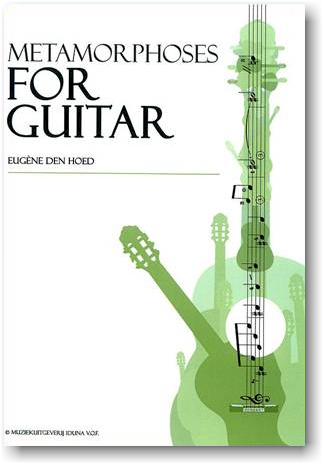
METAMORPHOSES FOR GUITAR
Muziekuitgeverij Iduna. 11 pp + CD.
Here are, to quote its subtitle, ‘Four Movements in a moderate contemporary style for grades 4 to 5’. It begins with an andante e poco rubato declamatory phrase , destined to return later. It is set around a centre of E, whilst not actually being in E minor, if you understand me. although at times it feels like EF minor. The part-writing stvle enables the composer to flow through some rather unusual ideas whilst still feeling admirably suited to the guitar. The first movement is generally in three voices.
Part Two is a piu mosso and the chromatic nature of much of the material makes it seem almost like a variation of Part One, which I am almost convinced it is! Again this is largely in three voices. The hardest movement is Part Three, marked again, piumosso but this time exhibiting much more complexity in its rhythms. A sudden slowing down leads to the opening movement’s declamatory motto theme before an attacca instruction leads one into the final Part Four, where the first slow section marked lento ma non troppo occurs. This however soon leads to a Dal Segno, taking one back to the beginning of Part Three for another turn around the hardest section, before a trip to the coda, where one is met by the motto once more.
A final thrusting flourish from Part Three the work closes on altered E minor chord. This is always very playable, if at times unusual, in its harmonic structures but nevertheless always understandable and involving. This is a more than interesting work that shows how versatile this composer is and just how good his back catalogue is. If you do not know of this man’s writings, have a look at his publisher’s website at www.eugenedenhoed.nl. and take a chance on some – they are well worth the effort.
Chris Dumigan – Classical Guitar

15 MODERN STUDIES
I have got used to Den Hoed’s beautifully evocative pieces over the years but here he has moved the goalposts somewhat. In this set of 15 pieces dedicated to Leo Brouwer, he has flexed his modernist wings more than ever before.
He lists the pieces as roughly Grades 5 -7 and
gives in the Foreword a description of the technical reasoning behind the pieces. Therefore, No 1 with its repetitive bass and multiple slurs is described as a study for staccato bass and slurs. Others include a study for the homogeneity of chords, a study for syncopated rhythms, a study for arpeggio and tremolo, and so forth. Quite often I was aware of how he had written some passages of the more modern material, as he tends to find a figuration on, say, strings 5 4, then repeats the same finger figuration, on the next two strings namely 4 and 3, or alternatively plays the same figuration on the same two strings but on a different area of the fingerboard. Study No7 is an example of this style of writing.
Not all the pieces are atonal/chromatic; for indeed some are very melodic and much nearer his normal style of composition. As a result there is a wide variety of styles and music here and indeed anyone used to Brouwer’s simple studies, will find nothing too scary here, either technically or musically.
Chris Dumigan – Classical Guitar

LA FRESCOBALDA by Girolamo Frescobaldi
Arr. for guitar by Eugène Den Hoed. Muziekuitgeverij Iduna. 1O pp. This famous piece is the one that Segovia arranged many moons ago, and that was subsequently published in the Schott Archives. I haven’t got access to that version now but if my memory serves me, I seem to remember that Segovia didn’t do the whole piece but left the final part out, for whatever reason.
This version consists of the Aria with four highly contrasting variations followed by a varied return to the Aria as a close, and immediately one feels that the work is well adapted to the guitar, and doesn’t at all feel it was written for anything else, which it of course was, that being the sign of a good arranger.
The Aria is Moderato with mostly three voices in evidence, although the odd larger chord does enter from time to time. The First Variation is marked piu mosso and the musical parts move around considerably more here. The Second Variation is an allegro and things get quite tricky here although never losing their inherent guitaristic qualities. No.3 is marked sostenuto and here there is more opportunity to show a more emotive side to the piece, whilst the final 4th variation is an allegretto. The final Aria repeat is varied from the original at the beginning, and the whole work closes on a florid cadence leading to a close on the tonic major.
This is a beautiful work that belies its non-guitaristic origins and succeeds in sounding fresh and original, and if the music of the 1600s appeals then this book will be fine for the moderately advanced players amongst you.
Chris Dumigan – Classical Guitar
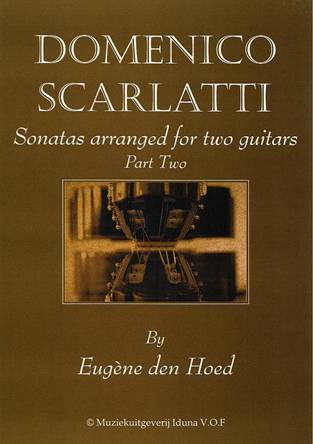
SONATAS ARRANGED FOR TWO GUITARS, PT. II by Domenico Scarlatti, arranged for two guitars by Eugène Den Hoed.
Muziekuitgeverij Iduna V.O.F. 42 pp (score only).
A chance to show your facility around the fingerboard.
Back in May 2014, I reviewed a book of Den Hoed’s two-guitar arrangements of some Scarlatti sonatas, and here is Part Two, with a further eight from the 550. As with the previous book, it is a score-only edition, and if the book has a fault it is that there are page turns in every piece. But that is the only caveat, for as with all this Dutch writer’s work, one finds great music beautifully arranged in a very
guitaristic manner, so nothing feels artificial, but rather natural as if originally written for two guitars.
In this collection, you’ll find Scarlatti’s KI/L366, K472/L99, K233/1467, K159/L104, K11/L352, K377/L263, K69/L382 and K533/L395. Six are in the original keys, with only K11 dropping from G minor to E minor, and K69 dropping a semitone from F minor to E minor, for guitaristic convenience. The musical styles within the eight are varied, with much opportunity to show your facility around the fingerboard, and plenty of places where the cantabile nature of the music is ideally suited to the guitar.
All in all, it’s another fabulous book of wonderful pieces, superbly arranged for two guitars, and providing you have the necessary facility around the frets (and that is nearly all of them!) you will certainly enjoy this fine book, as will any audience you present them to.
Chris Dumigan – Classical Guitar
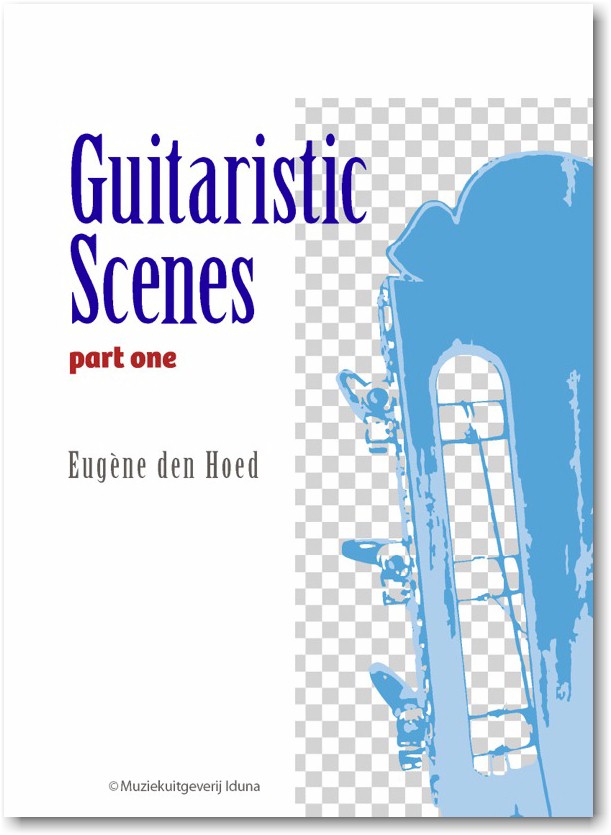
GUITARISTIC SCENES PART ONE by Eugène Den Hoed.
Muziekuitgeverij Iduna. 28pp.
The music of this composer is always interesting, engrossing and wonderfully written for the guitar. This book is no exception and consists of eleven pieces of modest difficulty and is sub-titled ‘impressions for guitar in different styles’.
His eclectic music heralds, no doubt, from the fact that he has been immersed in both popular and classical all his life and the crossover effect of much of his music is surely the result. It begins with Malaya, in a mixture of 6/8 and 9/8 with an open, almost modal sound that is almost impossible to describe. The music effortlessly moves around, occasionally reminding one of folk guitarists and their music. Small Talk follows with a melody that stays with you and a certain flow that is a result of the wonderful guitar writing he achieves. A Minor Blue is lots of fun and is (obviously) bluesy in character but not to the extent that it is a 12-bar, being more the overall feel of the piece that creates the sound of the blues, whilst Dolly’s Waltz is delightfully bizarre, with its reliance on intervals of a second, to mimic the static or wooden doll trying to dance a waltz.
Every one of the eleven pieces is really worth playing. I have a number of books from this composer and I have yet to find a dud in any of them. Great stuff!
Chris Dumigan – Classical Guitar (USA)

GUITARISTIC SCENES PART TWO by Eugène Den Hoed.
Muziekuitgeverij Iduna 0115 28pp.
First-rate music that is exceedingly playable, always entertaining. Over the years I have seen a substantial amount of this wonderful composer’s guitar music. Unlike many of his peers, he is completely successful writing very easy material (which is actually surprisingly difficult), intermediate pieces, and very difficult ones.
Remarkably, I never feel that he sacrifices his musical ethics writing easy material, and he always retains an individual style that is completely recognizable from the outset.-
This latest book consists of ten moderately difficult pieces subtitled “Impressions for Guitar in Different Styles.” It’s difficult to describe his way of writing.It often uses almost modal harmonies, with a penchant for open strings mixed in very naturally with fretted notes in a way that makes it slightly unusual, but perfectly acceptable and pleasant, harmonically speaking. You never really know exactly where the harmonies are going to land, and the surprise factor is often quite high. So, “Rondo” is marked con moto in a natural mix of three and four beats in a bar, with plenty of hammer-ons in an almost folk-like way. Then there is “Another Point of View,” in 8/8-grouped usually, but not always in a 3 +2+ 3 way—marked animato, which really keeps you guessing. There’s a brooding andante titled “Maquiaria” and the perhaps jazz—influenced “In a Mellow Taste,”plus many more.
This man’s music is unfailingly first-rate music that is exceedingly playable, always entertaining and gets your musical muscles working on high alert throughout.
If you’re not familiar with him, take my word for it and give him a try- you won’t be disappointed!
Chris Dumigan – Classical Guitar (USA)

LA GUITARRA OSTINATA by Eugène den Hoed.
Muziekuitgeverij duna, 10 pp.
Phillip Glass inspired this work of interesting patterns and shifting complexities. This man’s music is never boring, but instead is always inventive, with plenty of wonderful musical ideas, and as he is so prolific, it is surprising that more people haven’t taken his pieces into the concert hall. This latest one-movement work has a dedication to Philip Glass, and it is immediately apparent that Hoed has styled the work on some of Glass’ musical ideas. The piece has two entirely different sections, the first being a group of six eighth notes that you repeat three more times, before a new six-note pattern, which is played four times, and so on. The patterns themselves are almost hypnotic in nature, and usually bob around in an almost random fashion, with lots of hammer-ons and pull-offs in the middle to make this a harder piece to play than it at first appears (especially at the required speed of 152 quarter notes per minute).
To give you an idea, there are 24 patterns of six notes in the opening section, all slightly different from one another. Then, a sudden pause and a long-breathed chordal larghetto enters, with much use being made of slightly exotic and unexpected chords. After this temporary respite, the six-note repeating figures continue for another 24 different patterns before a final return to the larghetto, this time slightly embellished from the previous version. After a final 8 bars of six-note arpeggios, the piece is over.
This piece is certainly not easy but moderately advanced players will be able to cope with its ever shifting complexities. I found it entertaining and great for getting my fingers moving!
Chris Dumigan – Classical Guitar (USA)

MICRO MOVEMENTS for guitar by Eugène Den Hoed.
Muziekuitgeverij Iduna. 20pp. Dedicated to Abel Carlevaro
This Dutch composer’s pieces are always worth playing. He manages to write in a contemporary way without frightening your granny, whilst retaining a truly modern edge to it.
This latest set of modestly sized pieces (one page each) are for guitarists around grades 4-6 and although they often, being studies, have a technical bent to them, they are always musical and both interesting and rewarding to get your fingers into.
Many different techniques are ‘studied’ in these pieces and so it would be churlish of me to actually single any out but suffice it to say that the moods within are many and varied and the challenges you will face trying them out will task you but they are actually really worth the effort required. This is a very good publication to give your pupils or indeed one to try out at recitals, because musically they are more than interesting.
Chris Dumigan – Classical Guitar (USA)
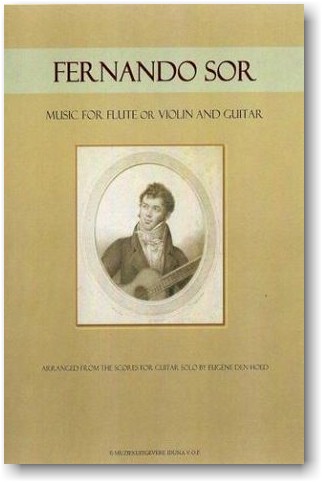
MUSIC FOR FLUTE OR VIOLIN AND GUITAR by Fernando Sor.
Muziekuitgeverij Iduna VOF. 32 pp.
The title is a little misleading in that it gives the impression that here is a collection of music originally for this instrumentation. In fact all these pieces were originally guitar solos have been arranged as duets by Eugène Den Hoed.
The originals are from opus 2, 31, 33, 35 and Sor’s ‘Method’ and quite a few should be known to the Intermediate player. Eugène Den Hoed has kept the technical level to around Grades 3-4 and as most of these pieces are of a highly lyrical nature, this publication could be of interest to ‘amateur’ duos and teachers (for sight-reading material).
The publication comes as score-only but the album contains no page turns and can easily be read by two players sharing a music stand.
Steve Marsh – Classical Guitar

SIMPLE FUN 16 easy pieces for guitar by Eugène Den Hoed
Muziekuitgeverij Iduna. 22pp + CD
This little set is aimed right at grades 2/3 and show of Eugène Den Hoed’s fine ability to write interesting music mostly in the first position. There are no tempo markings, as he prefers to leave that to the player’s own taste and technical abilities.
The pieces themselves are varied, melodic, and often with a tinge of modernity, just to remind you that this is contemporary music. They are printed in increasing difficulty with the opening few pieces mostly in two or three voices at the most and the final two or three involving some chords and slightly more densely written harmonies.
That said, they are all eminently suited to the pupil who wants to try something a little different but not too much so, and as such I can heartily recommend this fine book as definitely one to hunt
Chris Dumigan – Classical Guitar (USA)
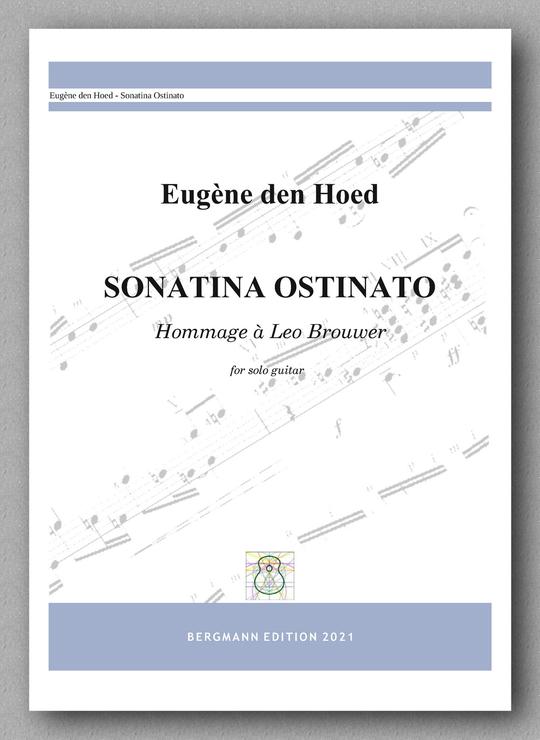
SONATINA OSTINATO for solo guitar by Eugène den Hoed, dedicated to Leo Brouwer.
Muziekuitgeverij Iduna VOF. 16 pp.
Eugène den Hoed used to teach at the Centrum voor de Kunsten in Bergen op Zoom and his past studies have included ones with with South American guitarist Baltazar Benítez. As well as studying classical guitar, he also has had strong connections with rock bands (e.g. the instrumental progressive rockgroup of the 70s, Bonfire) and has had a large number of original compositions and arrangements published by Muziekuitgeverij Iduna.
Over the past few years I seem to have reviewed number of editions of music written by Den Hoed and as far I can recollect I have never been disappointed by Sonatina Ostinato is a three-part work written in a contemporary fashion and dedicated to Leo Brouwer. The opening movement, an Allearo, is the obvious influence of the composition’s overall title, with its forward thrust of the evermoving syncopated melodic line and with its mildly caustic edge to it creating tension almost all the way through; quite an exciting beginning to the work.
A sense of serenity comes with the tranquil second movement, a short episode illustrating how to compose economically for the instrument and still retain musical interest. The animated finale brings the work to a stimulating conclusion with rapid scales and arpeggios leaping around the first twelve frets of the fingerboard to dramatic effect with just a brief few moments of serenity in the form of an interlude mid-way through.
Looking at the score, one might be forgiven for thinking that this work is much more technically difficulty than it actually is. I remember reading several years ago that Eugène den Hoed had the commendable ambition to write contemporary music aimed specifically at the Intermediate player. As this piece would be suitable for any grade 6 player seeking to extend their repertoire into the world of ‘modern’ music it seems that he is realising his ambition.
Altogether a most satisfying and welcome new addition to the repertoire.
Steve Marsh – Classical Guitar

ROBERT DE VISÉE SUITE EN D MINOR by Robert de Visée Arranged by Eugène den Hoed.
Muziekuitgeverij Iduna 0102 17 pp.
An old favorite that deserves a revival.
Karl Scheit (1909-1993) often found himself in the firing line. In the May 1955 edition of BMG, Jack Duarte (as he was then known) published a review of Scheit’s London recital from the March of that year. Even by Duarte’s outspoken standards, the criticism was unusually blistering. Over the next two decades, as Scheit’s published editions became ever more abundant, there was much harrumphing over such eccentricities as his penchant for adding slurs to transcriptions of 1l6th-century lute music. (I referred to this myself as recently as the October 2014 Classical Guitar.) Then there were Scheit’s fingerings, which gave every impression of having been devised by someone unfamiliar with the workings of the human hand. But let it also be noted that Scheit’s arrangement of the Visée’s Suite in D minor, which clearly formed the unacknowledged basis for the 1966 Bream recording, is dated 1944. This almost places Scheit on a chronological par with Emilio Pujol as a pioneering figure in the rediscovery of the modern guitar’s hitherto neglected forebears.
Scheit is again denied a credit in this curiously bound publication dating back to 2011, since the very fact that Eugène den Hoed uses Scheit’s revised order of movements and, like Scheit, skips the “Passacaille” altogether, leaves no doubt as to his source. Essentially, what this Netherlands-based guitarist/arranger provides is jazzed-up Scheit, followed by his own highly elaborate embellishments written out in full in the repeats. If memory serves, Leo Brouwer performed a similarly ornate Suite in D minor during a BBC broadcast in the late ’70s.
Eugène den Hoed’s efforts succeed, in that his trills and twiddles, although often tricky, are always playable and, unlike Scheit, his fingerings actually work. For reasons known only to him, he adds Italian tempo markings (but not metronome speeds) to all the movements, including the “Prelude.” This is an offense of which Scheit was sometimes guilty but, ironically, not in Suite in D minor. A pleasingly individualistic take on an old favorite that deserves a revival.
P.F. – Classical Guitar

SUITE IN E MINOR by Giuseppe Antonio Brescianello
Arranged for guitar by Eugène Den Hoed.
Muziekuitgevereij Iduna V.O.F. 11pp.
This Italian-born baroque composer’s music is not too widely known and therefore Eugène Den Hoed has done the guitar world a real service by arranging this wonderful four-movement suite for guitar. As I have recently found; not all baroque instrumental music is necessarily top-notch music but I have no qualms at all about this work which really sounds fine on our instrument and has more than a reminder of the great J.S. Bach in a good few places.
The suite begins with an Entree with both sections having written out repeats that have been embellished the 2nd time around. Without any evidence to the contrary, I can only assume that is the original, and not Den Hoed’s variations of what could have been a straight repeat. Whatever the answer they are superbly done and the whole effect is very convincing. A modest Minuet is next. The melodies and harmonies here as in the first movement are immediately appealing and yet have plenty of body in them, and also they fit beautifully under the fingers, and feel like true guitar original works. A lilting Siciliano follows on with a couple of places where the tricky looking runs are easier to play than they otherwise first appear. The final movement, as one might expect is a rollicking Gigue, marked ‘vivace’. It has to fly off the fingers to do it full justice, but it is a real showstopper, and any player giving it his all in a concert will no doubt reap the due rewards from the audience. This is a superb piece of music; concise yet full of emotion and depth with plenty of opportunity for the player to show off his technique too. This is a real find.
Chris Dumigan – Classical Guitar (USA)

THREE PIECES FOR GUITAR by Eugène Den Hoed.
Muziekuitgeverij Iduna. 20 pp.
This composer can always be relied upon to write beautifully structured music with a penchant for the individual harmony and the completely unexpected melody, whilst keeping the player occupied and engrossed throughout. This latest work is no exception.
The first movement is a Danza Nova set in a mixture of 9/8 and 6/8. After a repeated octave leading to a brief introductory statement, the piece begins for real with a musical idea based around a succession of three-note chords, (B , G and A7) that sound on paper as if they shouldn’t go together well, but they do. Everything begins mostly in quavers, although the difficulty factor goes up a step or two with the lightning-fast semiquaver runs that enter shortly afterwards, although they fit well under the hands. After a return to the opening three-chord idea a new light airy theme emerges on the top strings before a final return of the opening idea and its semiquaver companion before a final coda consisting of a bass note flourish and a glissando chord.
Moments of Dissonance is exactly that, namely a piece in mainly two voices which at times almost accidentally clash with a momentary dissonance before moving on. There is a large central section of long held chords that provide a welcome oasis from the opening idea that eventually returns only to make way for a sudden passage involving sextuplet semiquaver chords, before a return to the opening sections and a coda that leaves one deliberately in the air.
The final Asturioso references the Albéniz Asturias with quickly moving arpeggios underpinned by a moving bass melody. After a considerable time, a slower more relaxed middle idea enters marked Con Calma before a varied return to the initial arpeggio idea leads to a sudden quiet patch where the music slows down and the whole work ends in quiet harmonics.
Always interesting to play and never predictable, this latest work is quite challenging technically but like so many of his other works, well worth getting your hands around.
Chris Dumigan – Classical Guitar (USA)